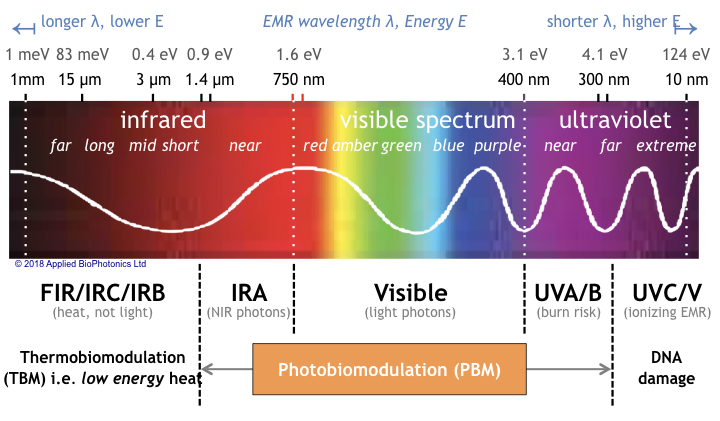More About Photobiomodulation
Wiki Article
The Best Guide To Photobiomodulation
Table of ContentsUnknown Facts About PhotobiomodulationThe Facts About Photobiomodulation RevealedA Biased View of PhotobiomodulationGet This Report about Photobiomodulation
Laser treatment is a clinical therapy that utilizes focused light to stimulate a procedure called. Throughout PBM, photons go into the tissue and engage with the cytochrome c complicated within mitochondria. This interaction triggers a biological cascade of occasions that leads to a boost in cellular metabolic rate, which can in addition to increase the healing process.There is consensus that the application of a therapeutic dose of light to damaged or inefficient cells leads to a mobile reaction moderated by mitochondrial mechanisms. Photobiomodulation. Research studies have revealed that these changes can affect pain and swelling, as well as, cells repair work
Changes in ATP, reactive oxygen types and nitric oxide adhere to light absorption by Cc, O. These effects are redox state and dosage dependent.

The Best Guide To Photobiomodulation
PBM tools have actually been removed for marketing by FDA with the Premarket Notification/510( k) procedure as adjunctive devices for the temporary alleviation of discomfort. These clearances were based upon the presentation of clinical information to sustain such cases (Photobiomodulation). In this treatment, a source of light is positioned near or touching the skin, permitting the light power (photons) to permeate tissue where it connects with chromophores located in cells causing photophysical and photochemical modifications that lead to changes at the molecular, cellular and tissue degrees of the bodyRemarkably, recent research study suggests that light can improve performance in typical cells and cells. The possible applications of PBMT are numerous and are being discovered experimentally at the basic scientific research, pre-clinical and medical level. The existing scientific uses are for the relief of pain and swelling and the treatment of sporting activities injuries.

The treatment specifications and number of sessions required for PBMT are dependent upon location and cause. PBMT typically calls for even more than one therapy for ideal pain relief.
The Main Principles Of Photobiomodulation
Treatment criteria for PBMT were initially established utilizing cells in vitro and in tiny pet designs. These therapy specifications usually had a low irradiance and fluence and worked well for cutaneous applications. When clinicians began to make use of PBMT to treat frameworks that were located deeper in the body, they utilized these Continued criteria with negative results.
We currently recognize that these negative research studies were due to inaccurate tool and therapy parameters for transcutaneous treatment of much deeper structures. Recent developments in laser treatment devices and even more research study right into the suitable does have significantly enhanced the results of PBMT. For dealing with deep cells, the wavelength of light used establishes the depth of penetration into a tissue.
For that reason, it is crucial that a medical professional makes use of the ideal wavelength of light and criteria to treat a condition. One wavelength and one set of treatment parameters will not work for all conditions. Adverse negative effects have not been reported from the use of PBMT (Photobiomodulation). Upgraded June 27, 2016Juanita j
Light therapy is a non-invasive therapy that functions by raising the capacity of the cell to develop power (ATP) to heal the location being treated. Because of this, it can lower swelling, swelling, and pain in the location. Study around is increasing, with even more in-depth research study documents connected below for those who would like to discover much more.
Examine This Report about Photobiomodulation
In the initial experiment, Dr. Endre Mester, used shaved rats and observing exactly how the laser affected their capability to expand hair compared to the group that was not receiving LLLT. He located that the team of mice obtaining LLLT had the ability to expand their hair back faster than the team of computer mice that didn't get LLLT (Hoon C, et al; 2012).This therapy is labelled by doing this to distinguish the distinction between the lasers some professions utilize to reduce (eg. in surgical treatments, or oral treatments). Low-level light treatment is painless, non-invasive treatment. It is made use of to decrease inflammation, swelling, and persistent joint disorders, decrease discomfort and increase injury healing of nerves and cells (Hoon C, et alia; 2012).
LLLT has a biphasic reaction, indicating that reduced dosages are generally seen to be much more valuable than greater dosages. That being claimed, dosages greater or lower than the optimal dosage doesn't affect (Hoon C, et al; 2012). For this reason, it can be tough to have studies on LLLT with numerous criteria.
Some companies incorporated both (LED and laser) to give an extra all-around therapy because lasers can permeate deeper than LED and infrared light (Norman Doidge, The Mind's Way of Recovery, 2015). During treatment, the area that is being dealt Check This Out with is subjected to LED light from a Biography, Flex Laser, which is at 660 nm wavelength, complied with by infrared light at 830-840 nm wavelength.
Report this wiki page